Raising Newt and Salamander Eggs
By Jennifer Macke
The following article is based on my experiences raising newts and salamanders from eggs. These instructions may not apply perfectly to every species, but should be helpful for raising most types. Raising newts and salamanders from eggs is challenging, but also very rewarding. You will need the following:
- some extra time in your schedule for the next few months (preferably with no vacations longer than a weekend)
- enough money to buy some essential supplies
- enough room to house the larvae and new newts
Much of the information in this article is anecdotal, rather than research-based. In biology, exceptions to the rule abound. However, if anything here seems wrong or could use improvement, please contact us. I thank the many other newt keepers who have provided information for this article. If you need information that is not provided here, ask at the Caudata Forum.
Egg laying
In captivity, most species lay eggs in the winter or springtime. Even indoors, they seem to pick up the cues that tell them it is the right time of year. Egg laying may last from 1 day to 3 months, depending on the species.
Be sure that you have some live aquatic plants in your tank. This may encourage breeding and egg laying. Many newts like to lay their eggs by wrapping a leaf around each egg as it is being laid. Having the eggs laid on live plants makes it easier to remove them from the tank and may also make it harder for the adults to find and eat their own eggs. Plastic strips made from clear trash bags may also be used as an egg-laying substrate. Surprisingly, some newts prefer plastic strips to real plants.
 |
 |
| Female Cynops
ensicauda laying eggs. Photo, Tim Johnson, 2002. |
Eggs of
Paramesotriton hongkongensis. Photo, Tim Johnson, 2002. |
 |
 |
| Eggs of
Cynops pyrrhogaster (Japanese firebelly). Photo, Joel Smith 2000. |
One egg
of Cynops ensicauda layed on a plastic strip. Photo, Tim Johnson, 2002. |
More photographs showing the details of egg and larval development are available in our Articles section. Developmental photo sets are available for several newt and salamander species.
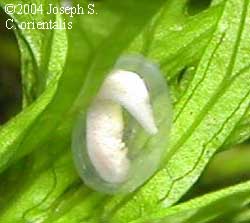
|
Care of eggs until they hatch
Many newts will eat their own eggs and larvae, so separation from the adults is a good idea. One approach is to remove the eggs from the adult tank as they are laid. Alternatively, if you already have many eggs and hatched larvae in with the adults, you many want to move the adults to a different tank.
Eggs can be kept in an aquarium or a small open container. Filtration is not essential. If the eggs are kept in an aquarium, the tank should have a source of aeration that does not make a strong current. Be sure the eggs are not too close to the airstone, or they will get tumbled around and battered by the bubbles. Alternatively, the eggs may be kept in a small open-topped container, such as the bottom half of a plastic jug. In this case, no aeration is needed (and could be harmful in such a small space). If using a small container, change about 50% of the water daily, and transfer the eggs to a clean container twice per week.
The time it takes from egg laying to hatching is species-dependent. A ballpark figure for the three species I have raised is 2 - 3 weeks. For Spanish ribbed newts, the time to hatching can be as short as one week. Some eggs will be duds. You can identify these because they become whitish/opaque and may get fuzzy. These should be removed and thrown away as soon as you see them, as it is risky to have fungus growing right next to good eggs.
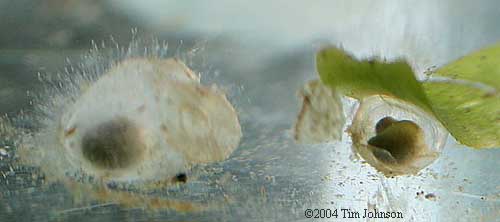 Bad egg getting moldy (left) compared to a good egg developing (right) at about 1-2 weeks after laying. |
Hatching!
When the larvae emerge from the egg, they will probably not need to eat immediately. You will be able to see a yellow or white stripe of yolk along their belly; this contains enough nourishment to feed them for the first few days. They may lay on their sides at first; this is normal. During those first few days, the larvae will change dramatically. As the yolk disappears, the tail will become broader and flatter, and the front legs may emerge.
On about the second or third day after hatching, try to start feeding them. When larvae eat, they make an obvious "hopping" motion as they grab the swimming food. Once you see them hop, you will know they are eating. Also, if you are feeding them brine shrimp, you will see that their bellies become orange.
 |
 |
| Two-week
old larva of Triturus karelinii. Photo, Jennifer Macke, 2001. |
Group
of Cynops ensicauda larvae. Photo, Tim Johnson, 2002. |
When it rains it pours
Some species lay hundreds of eggs in a season. What should you do if you have too many? First, think about sharing them. There are probably hobbyists who would be willing to pay for the shipping. There are certainly newt keepers who would be willing to take some of the young newts after they metamorphose. Newt eggs and juveniles can be safely shipped. See Shipping Caudates by Mail.
Second, you may need to cull the flock. If you see any obvious mutations or deformities, these larvae should usually be destroyed. A color variant might be worth saving, but a "spinner" (a larva that spins in circles instead of swimming straight) should be culled. If you still have a greater number than you and your tank size can handle, you may simply need to dispose of some of the smaller, weaker specimens. It is better to kill some than to risk the whole bunch. The results of overcrowding can kill or weaken all of them. Assume that you will need 1-2 gallons of space per larva by the time they are ready to metamorphose.
Note regarding culling: never release captive amphibians into the wild. The animals themselves may be a risk to local ecosystems, or they may carry diseases that pose a risk to other amphibians. For information on humane euthanasia, see Euthanasia for Amphibians.
Size matters
Do not put small and large larvae in the same tank together. The smaller ones may become dinner for the larger ones. Enough said!
Feeding (see Microfoods for Larvae.)
The biggest challenge in raising larvae is providing TINY, LIVE food. The kinds of foods needed for newt larvae are described in Microfoods for Larvae. Suitable foods include microworms, freshly-hatched brine shrimp, daphnia, live blackworms, live tubifex worms, live or frozen bloodworms, whiteworms, pond water, etc. Larvae need to eat frequently, so either leave live food with them all the time, or feed at least once per day.
Housing
Start the larvae in a small tank or a shallow container (for example, a plastic shoe box or the bottom half of a jug). If a shallow container is used, no airation is necessary. Do a partial water change EVERY DAY, especially if you are using a small container. Since most newly-hatched larvae do not actively swim after their food, the food must be present in the tank in rather high concentrations. This is why a small tank or container works best at the beginning. One keeper I know raises larvae in individual cups, with a 100% water change daily. This method works very well, but is labor-intensive.
As the larvae grow, it may be necessary to transfer them to a bigger tank/tub, or divide them into several tubs. If you do not have extra aquariums, plastic storage tubs can used. In my experience, the best set-up is a bare-bottomed tank with a few pebbles and live or plastic plants for hiding places. The bare bottom will make daily cleaning much easier. The larvae instinctively seek hiding places, so having plants will reduce their stress level.
Another alternative is to raise the larvae in the tank where they were laid. If the parents remain in the tank, they may eat the larvae, but in many cases they don't. Or the parents may be moved to another tank. There are often many micro-organisms present in an established tank that the larvae can feed on for the first weeks. If additional food is being added, it is essential to monitor the ammonia level in the tank.
Filtration for larvae is not essential, but if you do use a filter, be sure it does not create a strong current, and be sure that the filter cannot suck in the larvae. Filter intakes can be covered with a piece of nylon stocking. A sponge filter is ideal.
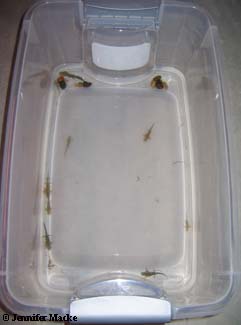 |
Illustrations of simple setups for raising larvae and terrestrial juveniles. LEFT: simple setup for larvae. No lid is necessary until the gills begin to shrink. Aeration can be added, but is not necessary as long as the water is shallow. BELOW LEFT: simple setup for metamorphs. When larvae approach metamorphosis, they can be kept in a slanted tub with water at one end. A lid is absolutely essential at all times. BELOW RIGHT: simple setup for terrestrial juveniles. Dishes are used to hold food items (in this case, live blackworms and chopped earthworms). Cork bark provides hiding places. No soil is placed under the food dishes, so that escaped food can be wiped away and does not foul the soil. A lid is absolutely essential at all times. |
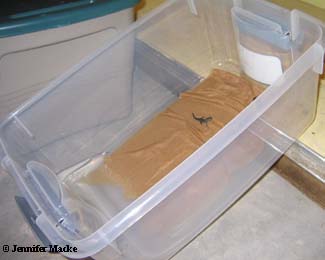 |
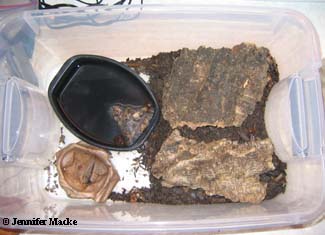 |
Rearing with adults
While there is always the risk that adult newts will eat their own eggs or larvae, a number of keepers have had surprisingly good luck with raising a few offspring in the same tank with the adults. This method is more successful in some species than in others. If the larvae escape predation, they are unlikely to die from issues related to water quality, as a well-established tank is the best housing. During the first weeks, the larvae are likely to be able to find existing micro-foods in the tank, as most healthy tanks harbor a healthy fauna of micro-organisms too small for us to see. After those first few weeks, keep the tank well-stocked with small live food, such as daphnia, blackworms, and whiteworms. In addition to feeding the larvae, this will keep the adults well-fed and reduce their interest in eating the larvae.
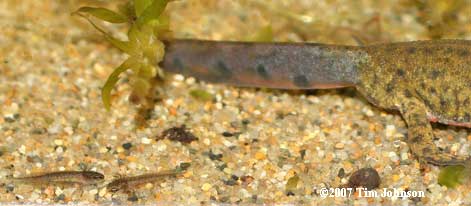 Larvae of some species, such as these Cynops pyrrhogaster, can be sucessfully raised in the same tank with adults. |
Water quality
Water quality is extremely important for larvae, and can be more difficult to maintain than for adult newts. If the larvae are kept in small containers, it is essential to change all the water daily, and clean out the inside surface of the container twice per week. Also, the larvae may need to be transfered to progressively larger containers (or fewer animals per container) as they grow. In an aquarium, it is necessary to clean out ALL debris daily. A siphon or basting bulb works well. A partial water change every few days is needed. There should never be any decaying food present in the tank. Because you will be putting food into the tank every day, check the ammonia level frequently. If you develop detectable ammonia, do frequent partial water changes or move the larvae to a larger tank. I find that the best tools for frequent cleaning are a kitchen basting bulb and/or siphon. See Water Quality for Aquatic Caudates.
 |
 Larvae of Neurergus kaiseri showing color changes as they approach metamorphosis. |
Metamorphosis!
Metamorphosis is probably the most exciting time in the process of raising young newts. The length of time between hatching and metamorphosis depends on the species, but among the species I have reared it has been 3-4 months. The early signs of metamorphosis are: changing coloration, shrinking gills, and gulping air from the surface. It is essential that you provide some land area that they can easily climb out on. It is also essential that the tank be escape-proof at this point, as some newts (especially fire-bellies) are notorious climbers, beginning from the moment they begin to morph.
As soon as a newtlet comes out on land, it may be necessary to move it to a separate tank with a more appropriate habitat. This habitat will depend on the needs of the species in question. After metamorphosis, most newts go through a terrestrial or semi-terrestrial phase. Most newts and salamanders stop eating during metamorphosis. Don't panic if the morphing newtlets don't eat for a week or so.
For fire-bellies, the best setup after metamorphosis is a very shallow aquatic tank with a large island area. Eastern newts have an eft stage and do best in a true terrarium. As soon as they completely lose their gills, the eastern newtlets can be put into the water bowl of the terrarium. They will come out to live on the land when they are completely ready. Spanish ribbed newts are an exception; they can remain semi-aquatic even as juveniles.
 Pile of Japanese firebellies after metamorphosis. Photo, Joel Smith 2000. |
Additional Resources
©2001 Jennifer Macke. Article written in 2001. Last updated January 1, 2004.
